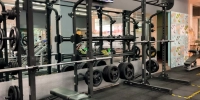Climbing Flexibility & Mobility: Unlock Your Performance & Prevent Injuries

For climbers, mastering movement is paramount, and at the core of efficient, powerful, and injury-free climbing lies flexibility and mobility. These two interconnected elements are not just beneficial; they are fundamental to unlocking your full potential on the rock or in the gym. This comprehensive guide will delve into why flexibility matters for climbers, its crucial role in climbing movements, and practical strategies to enhance your mobility, allowing you to navigate challenging routes with precision and control.
- Why Flexibility And Mobility Matter For Climbers
- The Role And Advantages Of Flexibility In Climbing Movements
- Consequences Of Neglecting Flexibility
- Incorporating Flexibility And Mobility Training Into Your Climbing Routine
- Conclusion
- FAQ: Your Common Flexibility And Mobility Questions For Climbers
- Why Is Flexibility Important For Climbing?
- What Is The Difference Between Flexibility And Mobility?
- How Often Should Climbers Train For Flexibility?
- What Types Of Stretches Are Best For Climbers?
- Can Poor Flexibility Lead To Climbing Injuries?
- Should I Stretch Before Or After Climbing?
- What Are Some Signs That A Climber Needs To Improve Flexibility?
Why Flexibility and Mobility Matter for Climbers
Flexibility, often defined as the passive range of movement in a joint or series of joints, works hand-in-hand with mobility, which is the ability to actively move through that range of motion with control. For climbers, this dynamic duo translates directly into enhanced performance, greater efficiency, and significant injury prevention. Understanding the importance of mobility for climbing is the first step towards optimizing your physical capabilities on the wall.
The Role and Advantages of Flexibility in Climbing Movements
Flexibility plays a vital role in a climber's ability to execute movements, adapt to diverse holds, and maintain efficiency on the wall. Its impact can be seen in several key areas that directly provide advantages to your climbing:
-
Increased Reach and Range of Motion: A flexible climber can access holds that might be just out of reach for someone with limited mobility. This expanded range of motion allows for greater efficiency in movements, reducing the need for multiple, less-efficient adjustments. It provides access to challenging stretches and enables fluid, dynamic movements, allowing climbers to adapt to various holds and positions with greater ease.
-
Improved Body Positioning and Balance: Flexibility enables climbers to contort their bodies into optimal positions. Whether it's bringing hips closer to the wall on a slab, flagging effectively on an overhang, or performing intricate knee-bars, improved body positioning directly translates to better balance. This makes moves feel more secure, less strenuous, and allows for more precise application of force into your feet.
-
Efficient Weight Distribution and Energy Conservation: The ability to move freely and adapt to different body positions allows for more efficient weight distribution across holds. By optimizing how you place your feet and move your body relative to the handholds, you conserve precious energy, which is crucial on longer routes or demanding boulder problems.
-
Adapting to Diverse Holds and Techniques: A greater range of motion allows you to adapt your body to different types of holds—slopers, crimps, pockets—and to utilize a broader repertoire of climbing techniques. This includes advanced maneuvers like high steps, drop-knees, heel hooks, and dynamic movements, broadening your overall climbing repertoire and problem-solving capabilities.
-
Injury Prevention: Flexibility is a crucial element in preventing injuries by mitigating muscular imbalances and preserving joint health. Limited flexibility can lead to overcompensation in certain muscle groups or place excessive stress on joints, increasing the risk of common climbing injuries like strains, sprains, and chronic issues such as tendonitis. Regular flexibility training helps maintain healthy muscles and connective tissues, making them more resilient to the repetitive and intense demands of climbing.
Consequences of Neglecting Flexibility
Ignoring flexibility training can have significant drawbacks, potentially hindering your progression and increasing your risk of injury on the climbing wall:
-
Limited Range of Motion: Without consistent flexibility work, your joints and muscles will become stiff and restricted. This directly limits your ability to reach far, perform high steps, execute deep body positions, and generally maneuver your body effectively on the wall. Such limitations can significantly cap your climbing potential and make even moderate routes feel more difficult and strenuous.
-
Increased Risk of Injury: Poor flexibility contributes heavily to muscular imbalances, where some muscles become tight and overactive while others are weak and underutilized. This imbalance places undue and uneven stress on joints, tendons, and ligaments, leading to a higher susceptibility to common climbing injuries like finger strains, shoulder impingement, hip flexor issues, and various types of sprains and tendonitis.
Incorporating Flexibility and Mobility Training into Your Climbing Routine
To unlock the full benefits of flexibility and mobility for your climbing, consistent and targeted training is essential. It is recommended to dedicate at least two to three sessions per week specifically to flexibility and mobility training, in addition to incorporating dynamic stretches into your warm-ups before climbing.
Here are practical strategies for enhancing climbing flexibility:
-
Dynamic Stretching: Perform dynamic stretches as part of your warm-up routine before climbing or any intense physical activity. These involve controlled, fluid movements that take your joints through their full range of motion, actively preparing your muscles for movement and increasing blood flow. Examples include leg swings, arm circles, torso twists, and controlled lunges.
-
Active Flexibility Exercises: These exercises involve moving a limb through its full range of motion using the strength of your opposing muscles, without external assistance. This improves both the flexibility of the target muscles and the strength within the newly gained range of motion. Examples include controlled leg lifts or active shoulder rotations.
-
Yoga or Pilates: Incorporating disciplines like yoga or Pilates into your training routine can significantly enhance overall flexibility, core strength, balance, and body awareness—all crucial for climbing. These practices emphasize controlled movements, sustained stretches, and breathwork that are highly beneficial for developing a more fluid and resilient climbing physique.
-
Mobility Training: Focus on specific joint mobility drills to improve the active range of motion around key climbing joints such as the hips, shoulders, spine, and ankles. This can involve exercises with foam rollers, resistance bands, or targeted bodyweight movements designed to articulate and lubricate the joints through their full natural range.
-
Regular (Static) Stretching: After your climbing session or on dedicated rest days, engage in static stretching. This involves holding a stretch at its end range for 20-30 seconds, aiming to gradually lengthen muscles and improve long-term flexibility. Focus on major muscle groups extensively used in climbing, such as hamstrings, hip flexors, lats, chest, and shoulders.
-
Progressive Flexibility Training: Like climbing itself, flexibility training should be progressive. Gradually increase the intensity, duration, and range of your stretches as your body adapts and becomes more flexible. Always listen to your body, differentiate between a healthy stretch and pain, and avoid pushing into discomfort that could lead to injury. Consistency over intensity is key for long-term gains.
Conclusion
Flexibility and mobility are not merely supplementary aspects of climbing training; they are integral to performance, efficiency, and longevity in the sport. By dedicating consistent effort to enhancing your range of motion and control, you will unlock new possibilities in your climbing, move with greater fluidity and power, and significantly reduce your risk of injury. Embrace flexibility as a cornerstone of your climbing journey, and watch as you reach new heights with greater ease and confidence, making every movement on the wall more effective and enjoyable.
FAQ: Your Common Flexibility and Mobility Questions for Climbers
Why is flexibility important for climbing?
Flexibility is crucial for climbing as it increases your reach, improves body positioning and balance, allows for efficient weight distribution, helps adapt to diverse holds and techniques, and significantly contributes to injury prevention.
What is the difference between flexibility and mobility?
Flexibility refers to the passive range of motion around a joint (how far it can be stretched), while mobility is the ability to actively move a joint through its full range of motion with control and strength. Both are essential for climbers for optimal movement.
How often should climbers train for flexibility?
It is recommended to dedicate at least two to three sessions per week specifically to flexibility and mobility training. Additionally, incorporating dynamic stretches into warm-ups before climbing sessions is highly beneficial.
What types of stretches are best for climbers?
A combination of dynamic stretching (for warm-ups to prepare muscles for movement) and static stretching (after climbing or on rest days to improve long-term range of motion) is ideal. Incorporating active flexibility exercises, yoga, or Pilates can also provide comprehensive benefits.
Can poor flexibility lead to climbing injuries?
Yes, neglecting flexibility can lead to a limited range of motion, muscular imbalances, and increased stress on joints, all of which elevate the risk of common climbing injuries like strains, sprains, and tendonitis.
Should I stretch before or after climbing?
Dynamic stretching is highly recommended as part of your warm-up before climbing to prepare your muscles and increase blood flow. Static stretching, which involves holding stretches for longer durations, is best performed after climbing sessions or on rest days to improve long-term flexibility and aid in recovery.
What are some signs that a climber needs to improve flexibility?
Signs that a climber could benefit from improved flexibility include difficulty reaching holds comfortably, feeling "bunched up" or restricted on the wall, struggling with specific techniques like high steps or drop-knees due to a limited range of motion, experiencing frequent muscle tightness, and recurring minor injuries.













